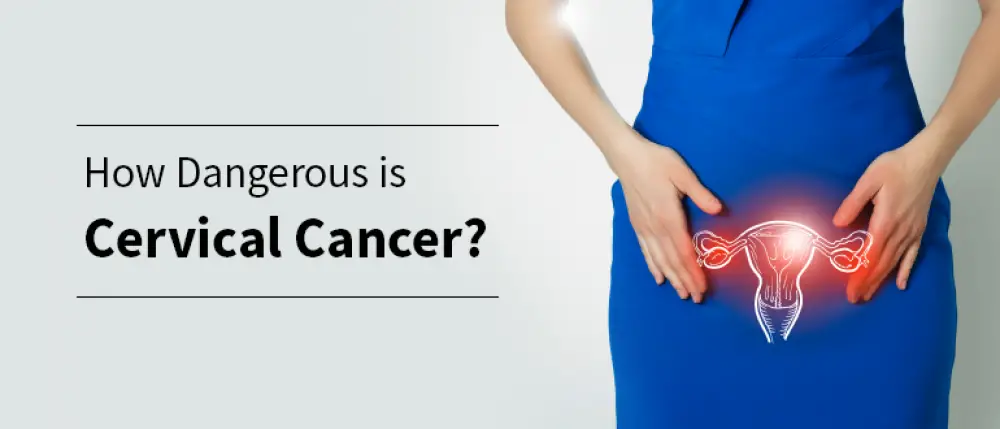HOW DANGERUOUS IS CERVICAL CANCER ?

Cervical cancer develops in a woman’s cervix (the entrance to the uterus from the vagina).
Almost all cervical cancer cases (99%) are linked to infection with high-risk human papillomaviruses (HPV), an extremely common virus transmitted through sexual contact.
Although most infections with HPV resolve spontaneously and cause no symptoms, persistent infection can cause cervical cancer in women.
Cervical cancer is the fourth most common cancer in women. In 2018, an estimated 570 000 women were diagnosed with cervical cancer worldwide and about 311 000 women died from the disease.
Effective primary (HPV vaccination) and secondary prevention approaches (screening for, and treating precancerous lesions) will prevent most cervical cancer cases.
When diagnosed, cervical cancer is one of the most successfully treatable forms of cancer, as long as it is detected early and managed effectively. Cancers diagnosed in late stages can also be controlled with appropriate treatment and palliative care.
With a comprehensive approach to prevent, screen and treat, cervical cancer can be eliminated as a public health problem within a generation.
The HPV (human papillomavirus) vaccination is recommended for girls and women to protect against certain types of HPV that can lead to cervical cancer and other associated cancers. The specific guidelines for HPV vaccination may vary by country and health organizations, but generally, the following recommendations are common:
* Age Range:
* The HPV vaccine is typically recommended for girls and women between the ages of 9 and 26.
* Vaccination Schedule:
* The vaccination is often given as a series of shots. The number of doses and schedule may vary by the specific HPV vaccine used. It’s essential to follow the recommended dosing schedule for optimal protection.
* Preferably Before Sexual Activity:
* Ideally, HPV vaccination is administered before the onset of sexual activity. This is because the vaccine is most effective when given before exposure to the virus.
* Boys and Men:
* In many countries, HPV vaccination is also recommended for boys and men, particularly to prevent the transmission of the virus and reduce the overall prevalence of HPV-related diseases.
* Target Population:
* The primary target population for HPV vaccination is often preadolescent and adolescent girls, typically starting around age 11 or 12. However, vaccination can be given as early as age 9.
* Catch-Up Vaccination:
* Catch-up vaccination is often recommended for females who did not receive the vaccine at the recommended age. This catch-up vaccination may extend into the late teens and early twenties.
* Special Populations:
* Individuals with weakened immune systems, such as those with HIV, may have different vaccination recommendations. In some cases, vaccination may be recommended up to the age of 45.
It’s crucial to consult with healthcare professionals or public health authorities in your region for specific guidelines and recommendations regarding HPV vaccination. Additionally, healthcare providers can provide information about the potential benefits and risks of the vaccine based on an individual’s health history and circumstances. Regular screenings, such as Pap smears and HPV testing, are still important for women, even if they have received the HPV vaccine, as the vaccine does not protect against all HPV types that can cause cancer.
The HPV (human papillomavirus) vaccination is recommended for girls and women to protect against certain types of HPV that can lead to cervical cancer and other associated cancers. The specific guidelines for HPV vaccination may vary by country and health organizations, but generally, the following recommendations are common:
* Age Range:
* The HPV vaccine is typically recommended for girls and women between the ages of 9 and 26.
* Vaccination Schedule:
* The vaccination is often given as a series of shots. The number of doses and schedule may vary by the specific HPV vaccine used. It’s essential to follow the recommended dosing schedule for optimal protection.
* Preferably Before Sexual Activity:
* Ideally, HPV vaccination is administered before the onset of sexual activity. This is because the vaccine is most effective when given before exposure to the virus.
* Boys and Men:
* In many countries, HPV vaccination is also recommended for boys and men, particularly to prevent the transmission of the virus and reduce the overall prevalence of HPV-related diseases.
* Target Population:
* The primary target population for HPV vaccination is often preadolescent and adolescent girls, typically starting around age 11 or 12. However, vaccination can be given as early as age 9.
* Catch-Up Vaccination:
* Catch-up vaccination is often recommended for females who did not receive the vaccine at the recommended age. This catch-up vaccination may extend into the late teens and early twenties.
* Special Populations:
* Individuals with weakened immune systems, such as those with HIV, may have different vaccination recommendations. In some cases, vaccination may be recommended up to the age of 45.
It’s crucial to consult with healthcare professionals or public health authorities in your region for specific guidelines and recommendations regarding HPV vaccination. Additionally, healthcare providers can provide information about the potential benefits and risks of the vaccine based on an individual’s health history and circumstances. Regular screenings, such as Pap smears and HPV testing, are still important for women, even if they have received the HPV vaccine, as the vaccine does not protect against all HPV types that can cause cancer.
